Practices sandwiched in between classes, trucking across the Midwest in a cramped car, a losing streak that’s redeemable by friendship – this might seem like a classic sports movie, but it’s actually the legacy of an unlikely and unseen sport in DePaul’s history: football.
When I started at DePaul, one of the first things I was taught about the fundamentals of American collegiate sports was an absolute lie.
“Football? We’re undefeated!” I remember hearing at orientation, followed by a laugh when it set in to the group of freshmen that we, in fact, don’t have a football team. I went years believing that we didn’t have a team at all, until I stumbled across a photo from 1900 of the team from St. Vincent’s College, the institutional predecessor to DePaul, while seeking distractions after a Zoom class.
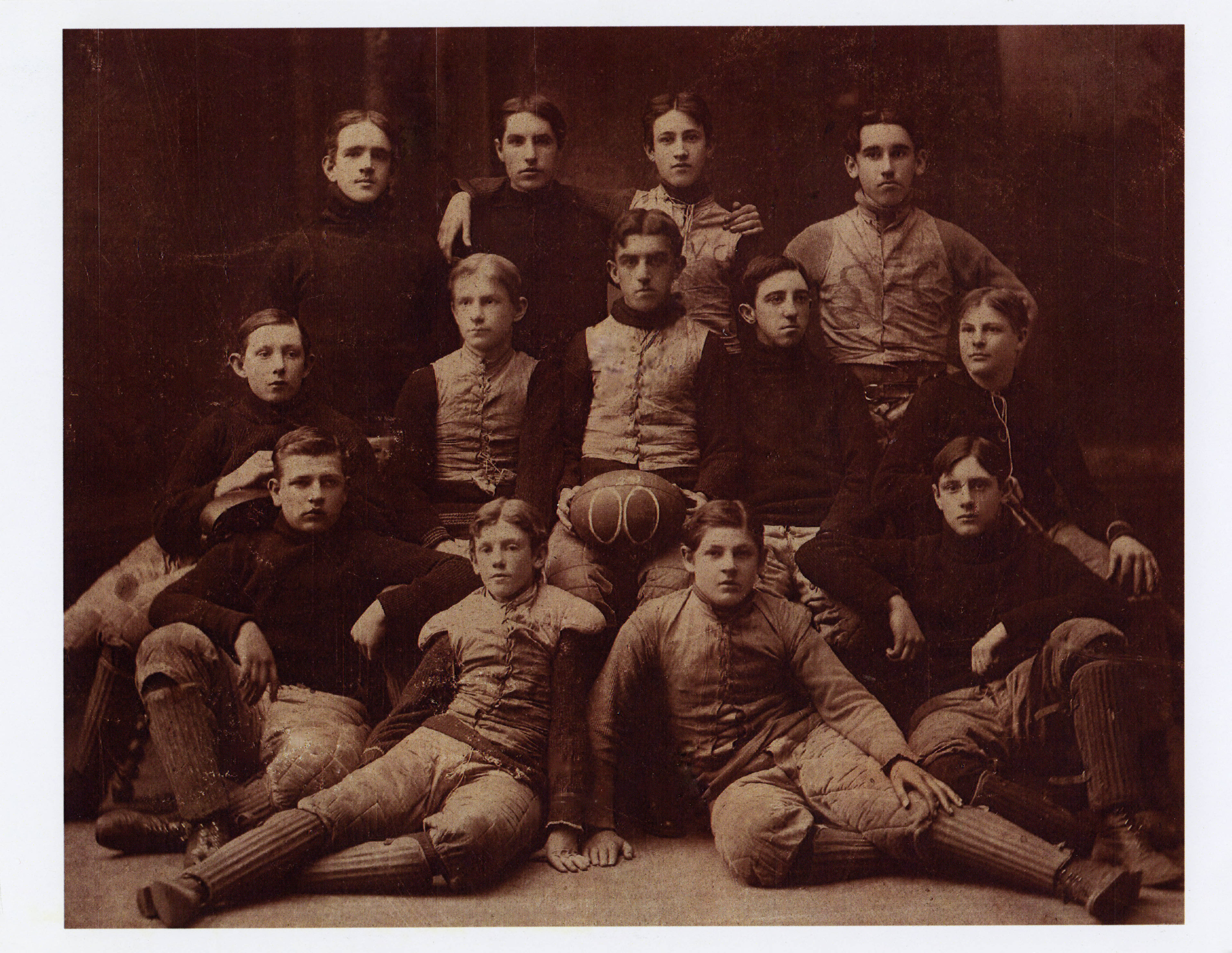
On the back of the photo, in pen, the photographer notes that the boy in the middle holding the football is Leonard I. Burns, Sr. (DePaul University Special Collections.)
I couldn’t stop staring at the faces of these kids who were supposed to be my age, from 120 years ago, grouped around a football about the size of their heads. All of these boys were living at the turn of the century, only years away from a major global pandemic, an economic recession-turned-Depression and a massive rise in unemployment. Seems pretty familiar, huh?
The history of DePaul’s football team is a spotty one, blipping in and out of student life from the start of St. Vincent’s College to only a few years ago. What started as a recreational staple in 1898 became a potential moneymaker by the 1910s and ‘20s, particularly with the successes of DePaul’s distant neighbors to the north (Northwestern University) and the south (University of Chicago), not to mention the skyrocketing popularity of a new team from Decatur, recently renamed the Chicago Bears.
But by 1938, then-president Michael O’Connell axed the team, leaving students and onlookers alike to wonder: what happened?
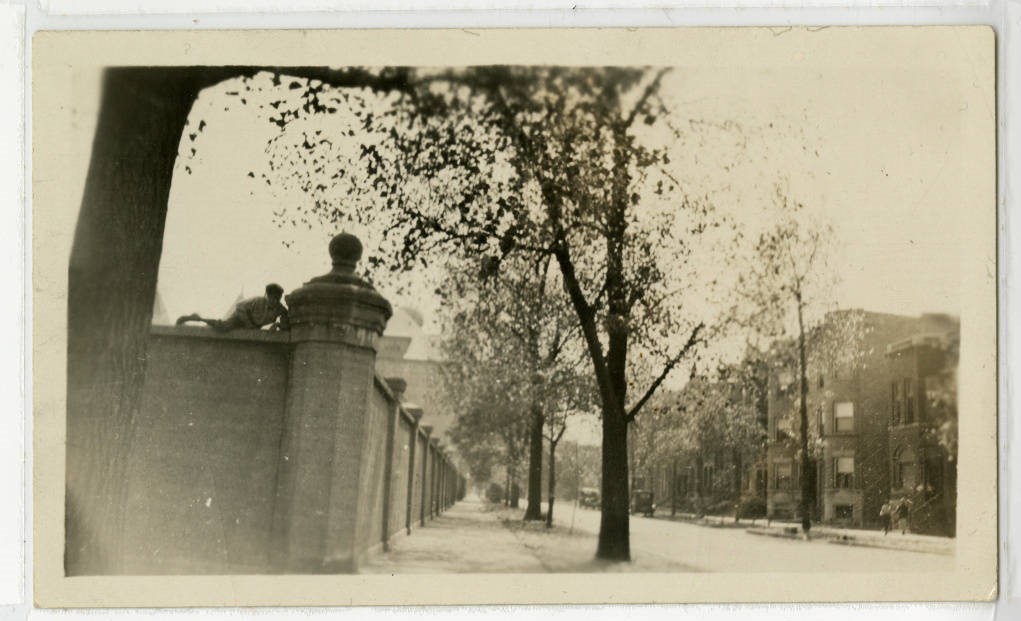
A student mounts the stone wall that fenced in the university’s athletic field that spanned the north end of Kenmore/Belden/Sheffield, where the Lincoln Park Student Center is now. (DePaul University Special Collections.)
Football has been a staple of college sports since 1869, when Rutgers and Princeton faced off in New Jersey. Using now-outdated rules and equipment to play that were more akin to soccer, the match marked two major milestones, standing as both the first soccer and first football game at the college level in the United States. (Rutgers won 6-4.)
Meanwhile, the soccer-football hybrid migrated to Chicago, and the first recorded college football game in the city, between Racine College (which folded in 1933) and the University of Michigan, was played on May 30 in 1879, at the Union Base-Ball Grounds on Michigan and Randolph – now Millennium Park, only a few blocks from DePaul’s downtown campus.
“The attendance was good, and enthusiastically cheered the contestants wherever opportunity occurred,” wrote a reporter the day after, in the Sunday edition of the Chicago Daily Tribune. “No bones were broken, but [Racine’s] Torbert was stretched on the turf once. A bucket of water, however, revived him.”
“No bones were broken, but Torbert was stretched on the turf once. A bucket of water, however, revived him.”
DePaul as an institution started out as St. Vincent’s College in 1898, and so did the football team. While it’s hard to nail down a first game for the school’s “football squad,” which bounced from name to name (Red and Blue, the D-Men and now the Blue Demons) the Chicago press circuit picked up the northside gridders in 1899 as they began facing off against high schools across the Chicagoland area.
Yes, you read that correctly – we played high schoolers. And according to sports historian Steve Riess, it wasn’t unusual for collegiate teams to play high school ones, particularly in the realm of football.
“Chicago had very good high school sports – enormous high school sports. Going back to the late 19th century, one sport that was particularly big in Chicago was football, and the best team was from Hyde Park,” Riess said. “In 1903, they played the mythical national championship against Brooklyn Polytech – they beat them 105 to nothing.”
Riess explained that because Hyde Park was a high school football powerhouse, many players went “across the block” to the University of Chicago, which was quickly gaining on major collegiate football teams to be the best in the country. Led to victory after victory by coach Amos Alonzo Stagg, the U of C Maroons put Chicago collegiate football on the map, with the team far surpassing the fledging D-Men.
St. Vincent’s College gave way to DePaul University in 1907 with the dedication of the university, though neither team ever made it into a conference for football: we were independent, playing a smattering of high school and college teams across Illinois and the Midwest. Briefly, DePaul was a part of the Western Interstate Conference, which ran from 1923 to 1927 and included teams like Loras College, St. Viator College and Valparaiso University, but it returned to its independent status when the conference folded.
This was in the face of the burgeoning “Intercollegiate Conference of Faculty Representatives,” a Midwestern league that we now know as the Big Ten, and though DePaul graduated from playing high school teams to playing smaller Midwestern colleges, it only broke through to play its more prominent neighbors on very rare occasions.
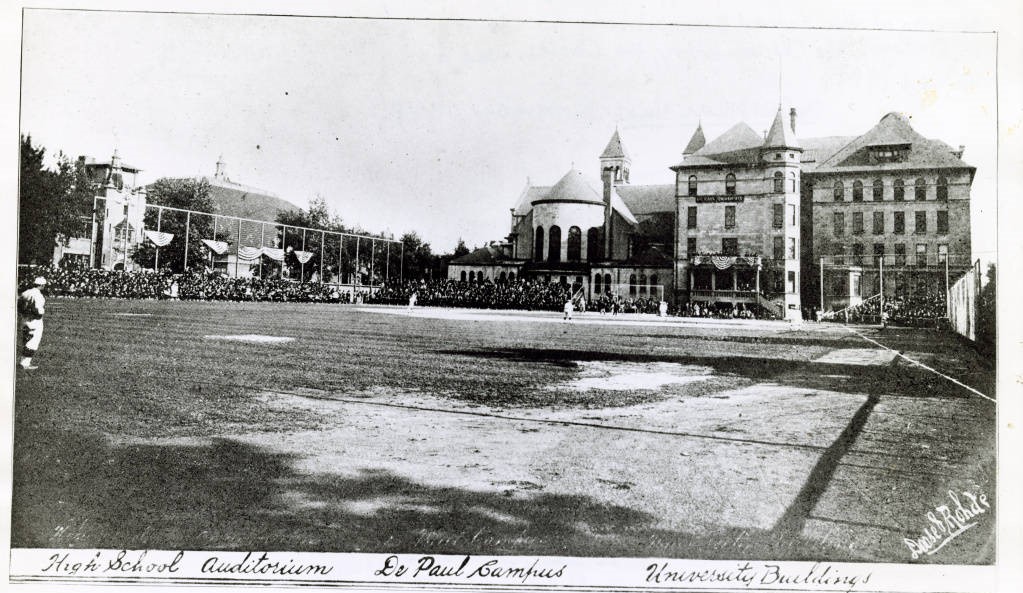
The Chi-Feds, a short-lived team in the short-lived Federal League, played on DePaul’s athletic field from 1913 to 1914, while Weeghman Park (later known as Wrigley Field) was under construction. (DePaul University Special Collections)
The Blue Demons practiced and played primarily on an athletic field at the corner of Belden and Sheffield, cordoned off from the rest of campus with a handsome stone wall (that students would climb from time to time). The field wasn’t just home to football – most sports and physical education at the university would take place there, in the shadow of Byrne Hall and the St. Vincent de Paul Church.
In 1953, DePaul found another use for the space, and broke ground on a new athletic center a few years later, named Alumni Hall. According to university archives, the building had a 5,200- seat gym, an auditorium, classrooms and a swimming pool, and while it was well-used and loved, the building was demolished in 2000 to make way for the current fixture, the Lincoln Park Student Center.
When they weren’t on campus, the gridders would play at venues like Wrigley Field, which was regularly home to DePaul’s football games at the time. The exchange was reciprocal, too – the Chicago Whales, more commonly known as the Chi-Feds and the third major Chicago baseball team to exist alongside the Cubs and Sox in the 1910s, played on DePaul’s athletic field in 1913 and 1914, according to notes scrawled on the back of a photo. And at times, DePaul would play at Soldier Field, switching off with the Chicago Bears and other collegiate teams.
For the university’s centennial, a group of DePaul professors and historians pulled together primary sources and alumni interviews to paint a picture of early student life and administration at the university. Though it wouldn’t be the first activity that a DePaul tour guide would bring up to new students, football was, unsurprisingly, prominent.
“Most student social activities revolved around the intercollegiate athletic schedule, and events such as the homecoming football game and various booster affairs were high points on the social calendar,” John L. Rury wrote in a section about student life and campus culture. “Yet there can be little doubt that there was a high level of student interest in campus activities staged in conjunction with athletic events, particularly football.”
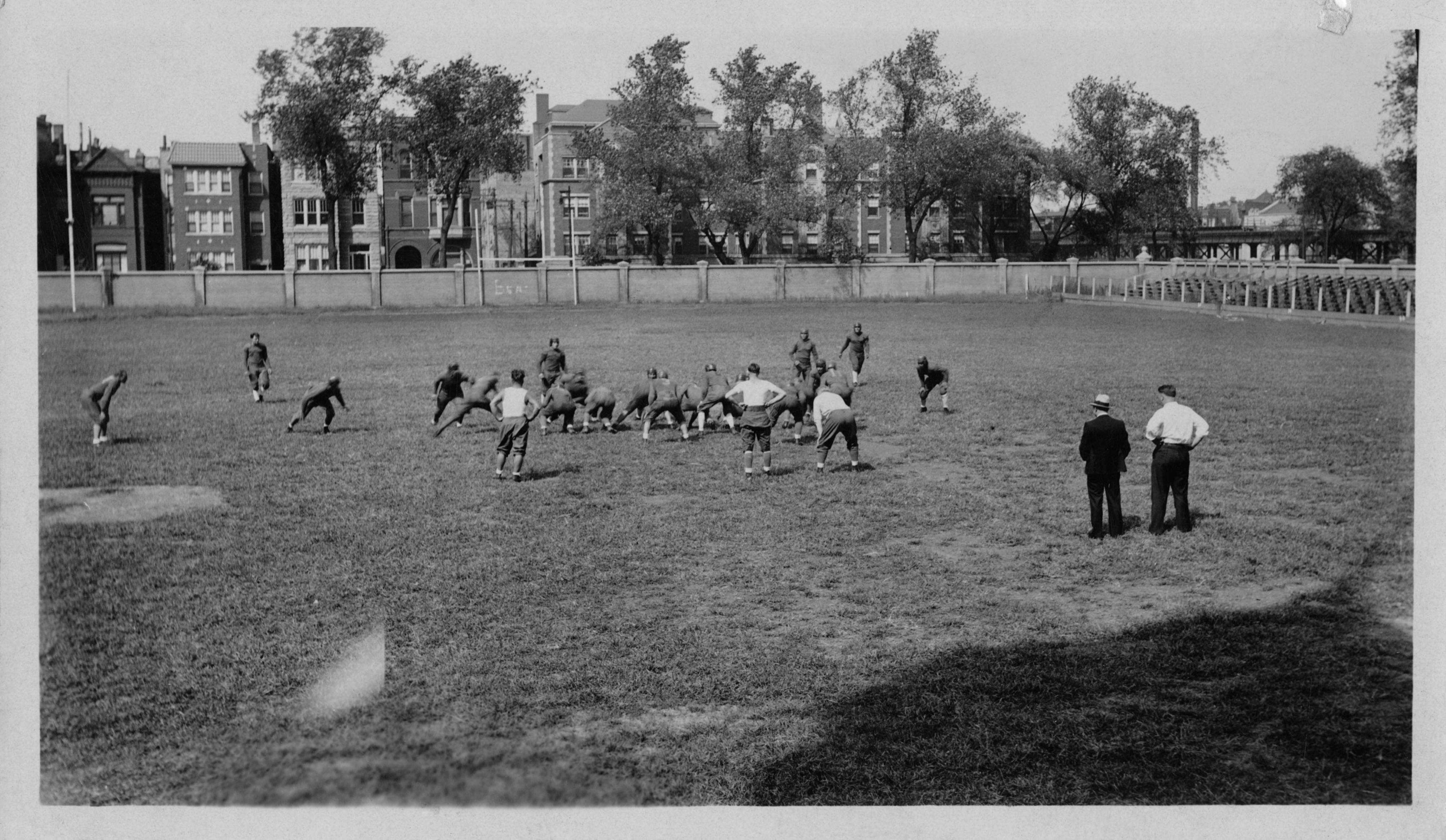
The 1930s-era team practices on DePaul’s old, stone-encircled Athletic Field, that students now know as the parking lot between the Student Center and the St. Vincent de Paul Church. (DePaul University Special Collections)
In 1938, then-president O’Connell decided to cut the team after a season that saw them outscored by 80 and finishing with a 2-7 record. The Associated Press covered DePaul’s “abandonment of the intercollegiate grid competition,” on December 13, quoting O’Connell, who said the team was cut because of “lack of sufficient interest to justify the cost of the football program.”
DePaul’s team wasn’t great, to put it bluntly. While the data is incomplete, on paper between 1901 and 1938, we won around 100 games to 93 losses, with 17 ties. But despite this dismal record, football seemed inseparable from the social scene at DePaul, and Rury noted that in the years following the cutting of the team, attendance at school dances and overall school spirit declined.
“While the ‘spirit’ phase of student life at DePaul faded with the demise of football in the late 1930s and the activities that went with it, a host of other functions sustained a vital campus culture,” Rury wrote. “Like many other urban Catholic institutions, the university discontinued its football program in 1938. At the same time, participation in dances of all sorts fell only slightly, though the number of dances diminished a little, too.”
So, it couldn’t have been a lack of interest – instead, it came down to the fact that thirteen members of the 1937 team “had been drawn upon by the graduating disease,” according to the 1939 yearbook. The lack of senior members, combined with injuries early on in a game against Ripon College and the lack of extra bodies on reserve, contributed to the team meeting its untimely end.
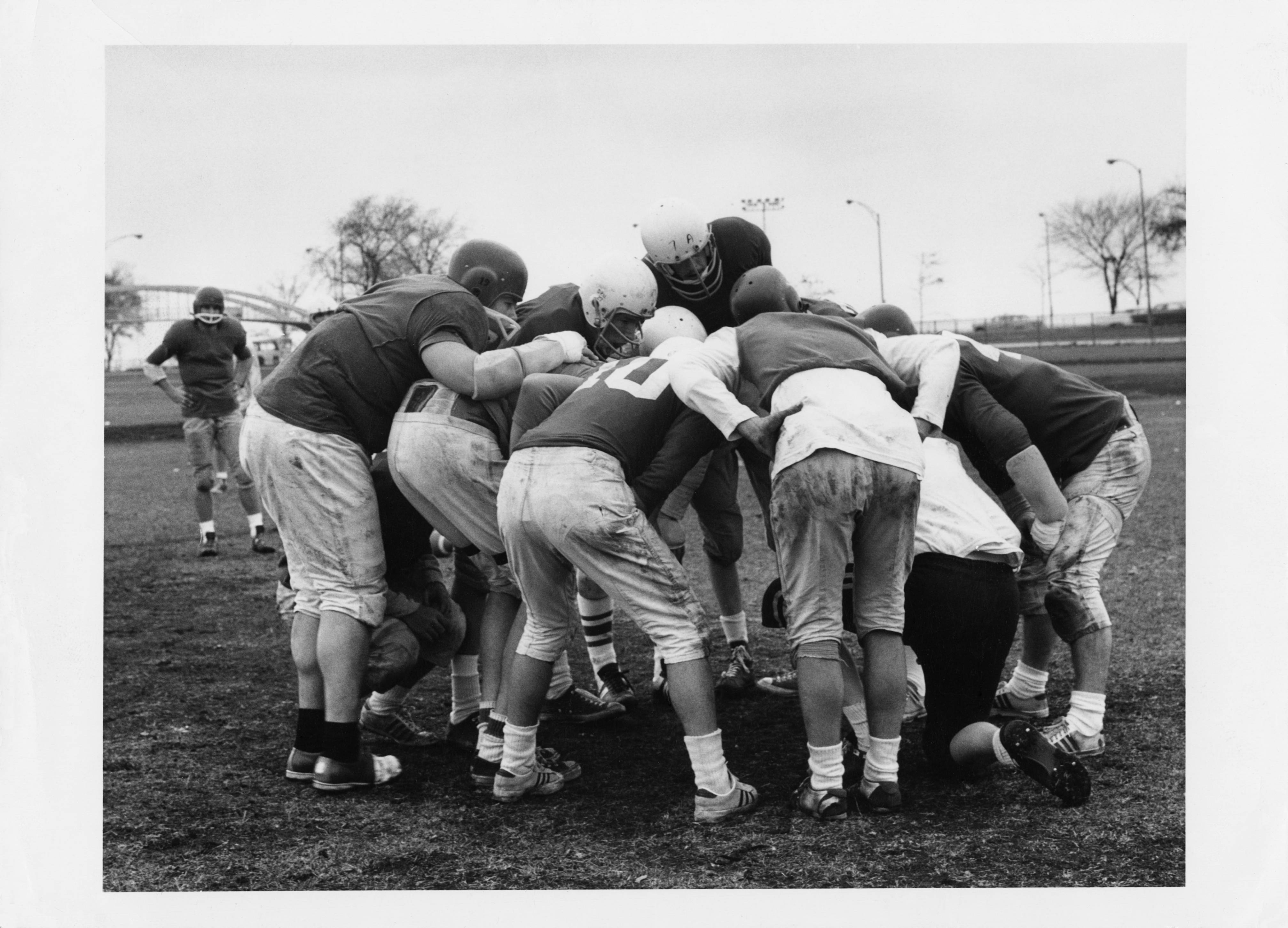
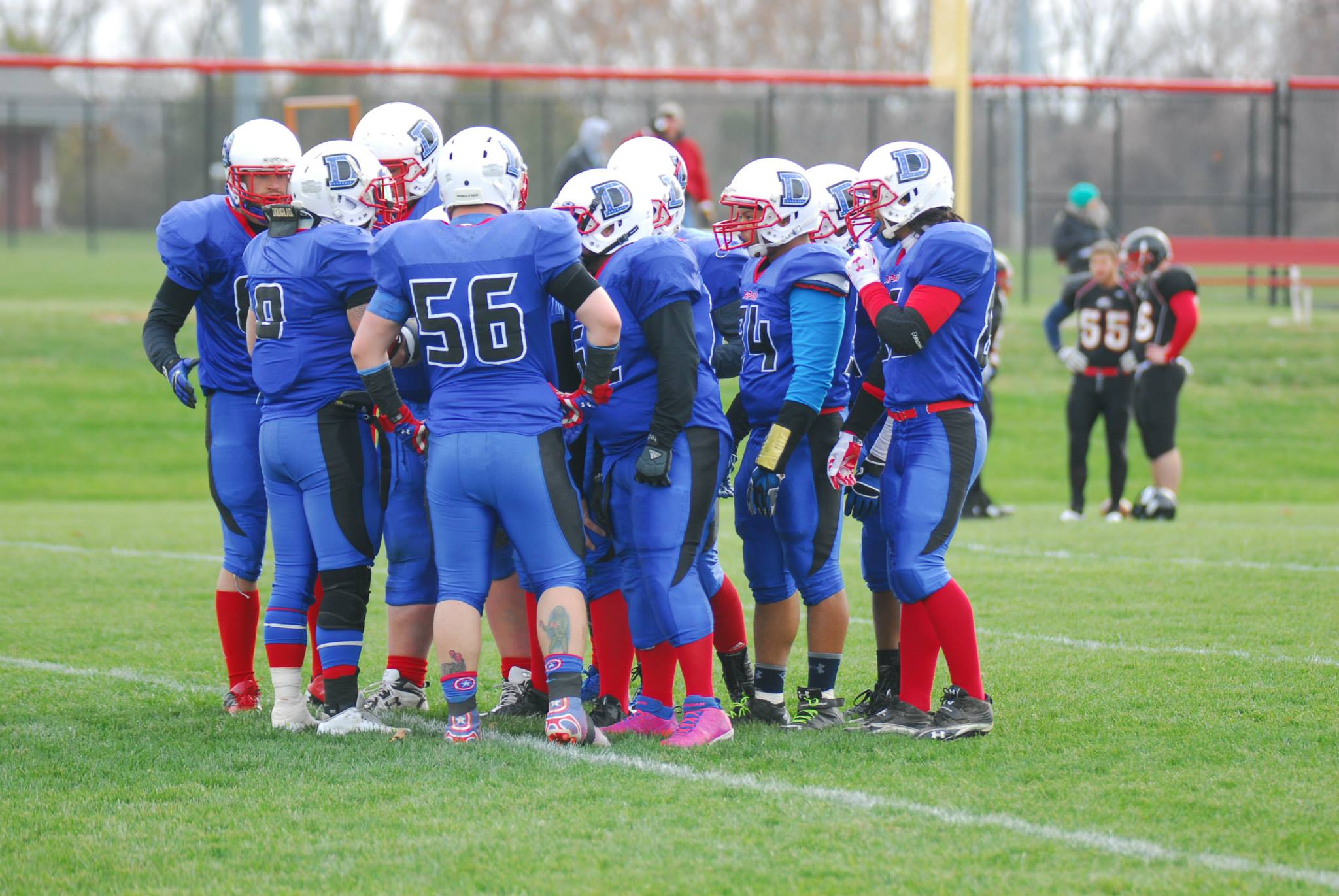
On the left, DePaul intramural football players huddle up on the field in the 1980s. On the right, the DePaul Club Football team does the same at, in 2014, at a game versus Southern Illinois University Edwardsville. (Courtesy of DePaul University Special Collections/DePaul University Club Football)
Outside of the official team, DePaul has had a variety of informal incarnations of football over the years, like club and intramural teams. Intramural football skyrocketed in popularity in the 1970s and 1980s, and many Chicago universities had teams that did pretty well, complementing the Bears’ success.
But its most recent incarnation took the shape of DePaul Club Football, a venture created in part by Riley Halligan in 2013 when he was a junior studying game development.
“I got to campus, and I realized that there was a legitimate hunger for a football team,” he told me. “Pretty much everyone was making jokes like, ‘Oh, we’re undefeated, that’s awesome,’ but at the same time there were a lot of people who were like, ‘We should have a football team, I don’t understand why we don’t.’”
Halligan, who played football in high school at Hinsdale Central, gathered the support from classmates and friends to form a student organization, which he said was no easy feat. The club needed significant financial support to buy things like equipment and apparel, and one more critical component as well: space, a hard commodity to come by in a neighborhood like Lincoln Park.
The club football team was entirely independent from DePaul Athletics, so Halligan and his friends couldn’t rely on the university for practice and competition space. Instead, they had to apply for time slots at Wish Field, which Halligan said was often challenging because of varsity sports, and they often found themselves playing a little farther north, bouncing between Rogers Park and Evanston with Loyola University Chicago’s club team.
At one point, the team rented out the football field at Benedictine University in suburban Lisle in order to host a game – this is common practice, according to Halligan, and if their school doesn’t have a football field to play on, teams will turn to high schools or other colleges in order to play games and run practices.
Ultimately, the DePaul Club Football team met the same fate that the original gridders did: the lack of financial support from the university, combined with a large graduating class from the team and a losing record, caused the team to fold after only two years, in 2015.
“It’s what happened to us, too,” Halligan said, referencing the original team’s issues with restocking after graduation. “Well over half of our players were graduating seniors, and they all graduated out. We had to get a whole new board and effectively a new team, plus a new coach.”
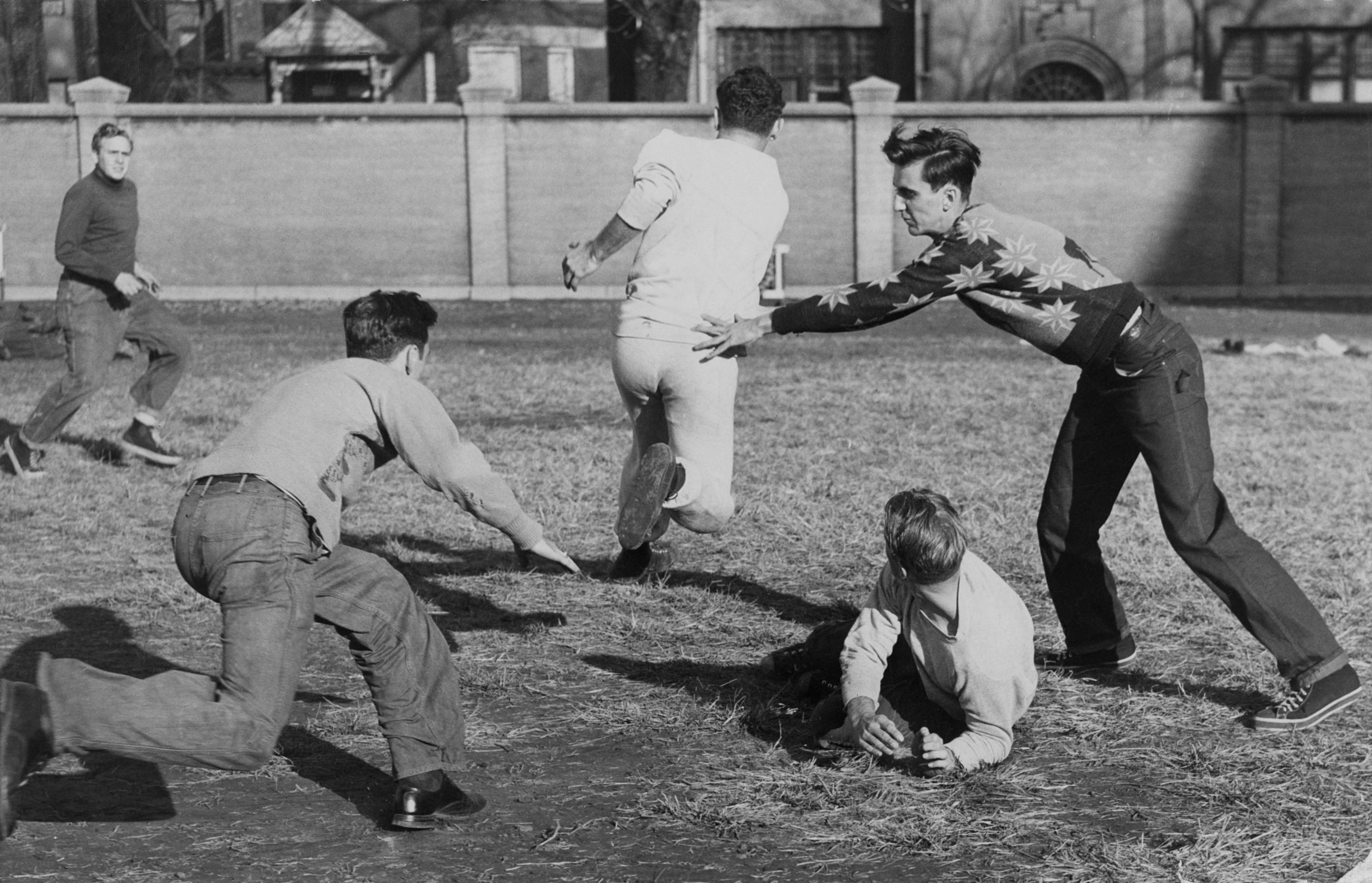

On the left, students play intramural football on the Athletic Field in 1950. On the right, DePaul Club Football faces off against Loyola University Chicago’s club team in 2014. (DePaul University Special Collections and The DePaulian / DePaul Club Football)
On that note, Halligan has a word of advice for those looking to start a football team at DePaul: “Be patient and be slow.”
“I think it’s really easy to get caught up in the excitement of starting something and being the founder or president, and all of that,” he said. “Be willing to reach out to other people – everyone in the club game is really supportive of everyone else. At the end of the day, yes, we want to win, and yes, we want to be champions, but if another team reached out to us and was like, ‘Hey, we’re struggling’… we would help those guys in any way we can.”
He shared that when the team was just getting off the ground and playing exhibitions with Loyola, the team didn’t hesitate to help make DePaul better.
“We went over there and just played seven-on-seven, and we had no idea what we were doing – we were just kind of running plays we had done in high school, this weird, discombobulated thing,” Halligan said, laughing. “Loyola’s offensive coordinator at the time actually walked across the field and showed us his entire offensive playbook and was like, ‘We’re gonna run these plays and get you all on one collective page, and hopefully you guys will have a little bit better of a time than you’re having right now.’”
One thing that shone through the club football circuit, both at DePaul and beyond, was a sense of camaraderie. Halligan pointed out how even though their collegiate sports career is long behind them, the team still stays in touch; before the pandemic had him scrambling to change plans, one DePaul club player invited the entire team to his wedding – including players from Loyola.
“You don’t really remember the scores or the games or the wins or losses, or individual plays,” Halligan said. ”You just remember all the fun stuff that you did with your teammates.”
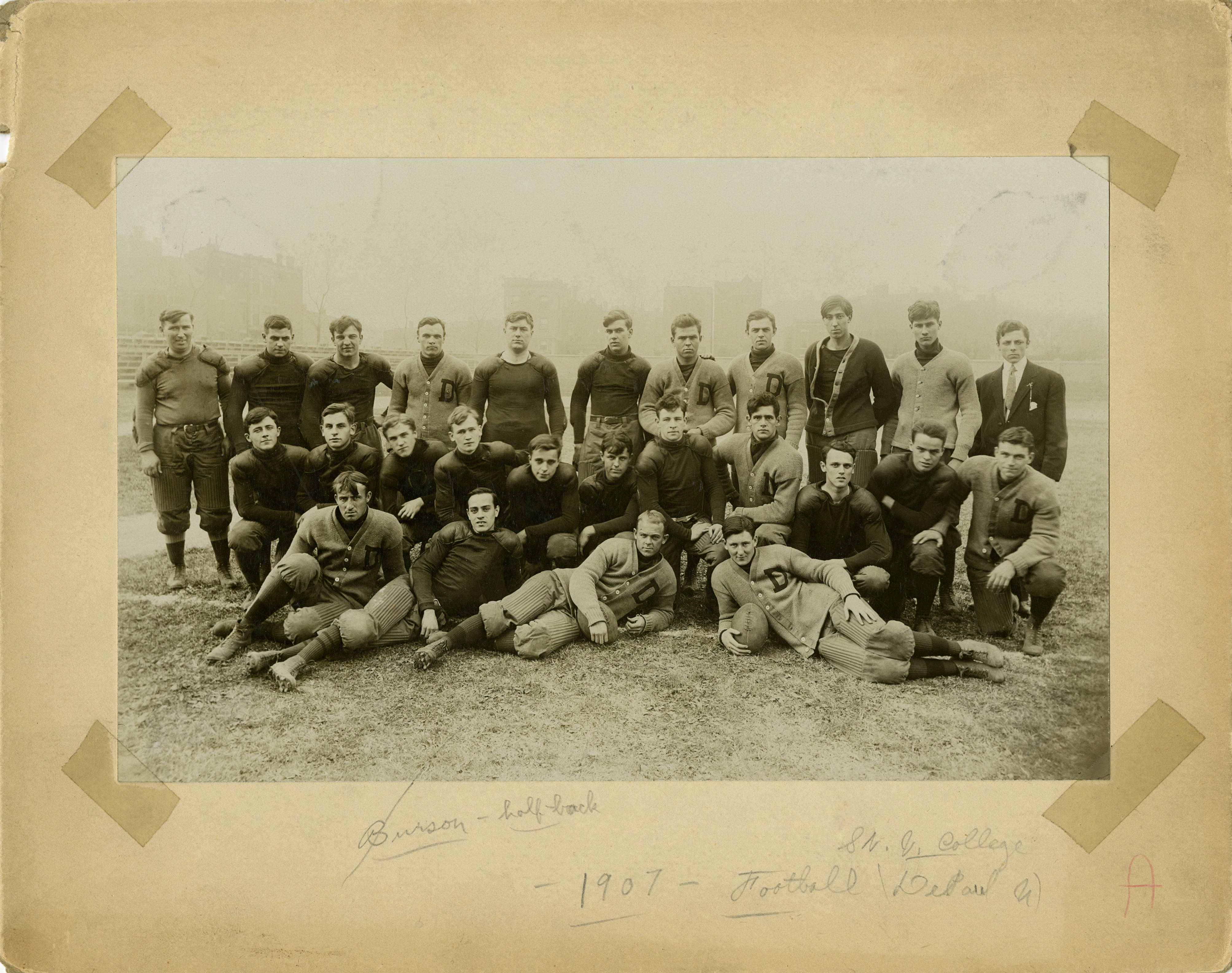
The football team in 1907, when St. Vincent’s College became DePaul University. (DePaul University Special Collections)
Even though they’re separated by almost a century, DePaul’s original Red and Blue gridders and its contemporary club counterparts aren’t too far removed in spirit. The original team’s last game was November 24, Thanksgiving Day, against Wichita University – and we lost, 13 to 31, in front of a 5,000-strong crowd. The team didn’t know it then, but that would be the last time they’d put on a jersey.
“Credit cannot be given more deservedly than to those Demonai who played out their hearts in a cause destined to lose,” the 1939 yearbook wrote. “It was a team which we feel would have gone places but for the breaks determined upon by the gods whose charge it is to govern the fortunes of those athletes of the gridiron game.”
In the header, members of the 1938 DePaul football are superimposed on a chess board with the caption “Connor’s Pawns, Checkmate Opponents” in the 1939 yearbook. (The DePaulian, DePaul University Special Collections)




NO COMMENT